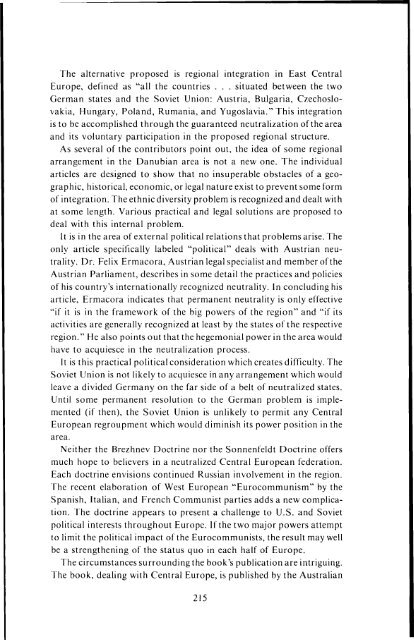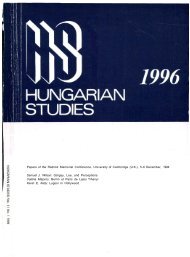talent enables Wass to depict the sufferings <strong>of</strong> his people in a mannerpalatable even to non-<strong>Hungarian</strong>s.Wass's new book. Sword and Sickle, is an historical novel. Part 1 is achronicle, not only <strong>of</strong> a family, but also <strong>of</strong> the <strong>Hungarian</strong> nationthrough nine hundred years. <strong>The</strong> author's breadth <strong>of</strong> knowledge isrevealed by his description <strong>of</strong> a people's evolution, spirit and traditions.<strong>The</strong> second part is a description <strong>of</strong> the modern age, the era <strong>of</strong> the SecondWorld War. It is not a dull report on the politics and diplomacy <strong>of</strong> theday, but a lively, touching story <strong>of</strong> a people, the <strong>Hungarian</strong>s <strong>of</strong> Transylvania.It carries the reader with the story and makes him share thejoys,grief and cares <strong>of</strong> the novel's heroes. <strong>The</strong> author's message is clear. It iswrong to place the burden <strong>of</strong> guilt for the <strong>Hungarian</strong>s' misfortunes onscapegoats such as the "aristocracy" or the "clergy". <strong>Hungarian</strong>s werecollectively responsible for the tragedy that overtook them, and they allmust individually bear the burden <strong>of</strong> that responsibility.<strong>The</strong> sword and the sickle are symbols. <strong>The</strong> former is indispensable inthe conquest <strong>of</strong> the homeland and its defence against external foes. Butone can retain the homeland only with the sickle, the plow: through thecultivation <strong>of</strong> the soil, through backbreaking and honest toil.Wass has received many literary honours, but he has not stoppedwriting. He has now presented us with a unique book which combinesjoy and sadness, encouragement and warning. This is a work <strong>of</strong> eternalvalidity, for today's man, who has conquered space but keeps stumblingon earth, needs moral guidance. After readingthis book the despondentwill raise his head, the sad will smile, and those who had lost hope willdiscover light in the seemingly dark future. What more can a writer <strong>of</strong>ferto his readers?HollandErzsebet KisjokaiQuest for a New Central Europe: A Symposium. Edited by JuliusVarsanyi. Adelaide - Sydney: Australian Carpathian Federation, 1976.295 pp. ISBN 0 9597246 0 3.In his introduction to the work. Dr. Varsanyi describes its purpose inthe following terms:This is not an attempt to pass moral judgements on a particularpolitical reality, but rather, a scrutiny <strong>of</strong> its underlying facts andsuperimposed features, in an attempt to determine the degree <strong>of</strong>validity <strong>of</strong> this reality, and the viability <strong>of</strong> an alternative form <strong>of</strong>regional arrangement.
<strong>The</strong> alternative proposed is regional integration in East CentralEurope, defined as "all the countries . . . situated between the twoGerman states and the Soviet Union: Austria, Bulgaria, Czechoslovakia,Hungary, Poland, Rumania, and Yugoslavia." This integrationis to be accomplished through the guaranteed neutralization <strong>of</strong> the areaand its voluntary participation in the proposed regional structure.As several <strong>of</strong> the contributors point out, the idea <strong>of</strong> some regionalarrangement in the Danubian area is not a new one. <strong>The</strong> individualarticles are designed to show that no insuperable obstacles <strong>of</strong> a geographic,historical, economic, or legal nature exist to prevent some form<strong>of</strong> integration. <strong>The</strong> ethnic diversity problem is recognized and dealt withat some length. Various practical and legal solutions are proposed todeal with this internal problem.It is in the area <strong>of</strong> external political relations that problems arise. <strong>The</strong>only article specifically labeled "political" deals with Austrian neutrality.Dr. Felix Ermacora, Austrian legal specialist and member <strong>of</strong> theAustrian Parliament, describes in some detail the practices and policies<strong>of</strong> his country's internationally recognized neutrality. In concluding hisarticle, Ermacora indicates that permanent neutrality is only effective"if it is in the framework <strong>of</strong> the big powers <strong>of</strong> the region" and "if itsactivities are generally recognized at least by the states <strong>of</strong> the respectiveregion." He also points out that the hegemonial power in the area wouldhave to acquiesce in the neutralization process.It is this practical political consideration which creates difficulty. <strong>The</strong>Soviet Union is not likely to acquiesce in any arrangement which wouldleave a divided Germany on the far side <strong>of</strong> a belt <strong>of</strong> neutralized states.Until some permanent resolution to the German problem is implemented(if then), the Soviet Union is unlikely to permit any CentralEuropean regroupment which would diminish its power position in thearea.Neither the Brezhnev Doctrine nor the Sonnenfeldt Doctrine <strong>of</strong>fersmuch hope to believers in a neutralized Central European federation.Each doctrine envisions continued Russian involvement in the region.<strong>The</strong> recent elaboration <strong>of</strong> West European "Eurocommunism" by theSpanish, Italian, and French Communist parties adds a new complication.<strong>The</strong> doctrine appears to present a challenge to U.S. and Sovietpolitical interests throughout Europe. If the two major powers attemptto limit the political impact <strong>of</strong> the Eurocommunists, the result may wellbe a strengthening <strong>of</strong> the status quo in each half <strong>of</strong> Europe.<strong>The</strong> circumstances surrounding the book's publication are intriguing.<strong>The</strong> book, dealing with Central Europe, is published by the Australian
- Page 1 and 2:
Canadian-American Review of Hungari
- Page 3 and 4:
Canadian-American Review of Hungari
- Page 5 and 6:
Canadian-American Review of Hungari
- Page 7 and 8:
Canadian-American Review of Hungari
- Page 9 and 10:
the best possible settlers who woul
- Page 11 and 12:
than a decade later they were follo
- Page 13 and 14:
Sociologists have yet to explain sa
- Page 15:
fifteen minutes, and spent the rest
- Page 18 and 19:
from the "Canadian poetry" of Icela
- Page 20 and 21:
garian community of Western Canada,
- Page 22 and 23:
lowed translations from other, more
- Page 24 and 25:
which took place in the pages of th
- Page 27 and 28:
from teaching in 1968, Kirkconnell
- Page 29 and 30:
Magyar poets and writers to the rea
- Page 31 and 32:
tive of his helpful attitude and un
- Page 33:
33. Kirkconnell, A Slice of Canada,
- Page 36 and 37:
The groaning of the slaves on Egypt
- Page 38 and 39:
ecause most such lines are imbedded
- Page 40 and 41:
;Two spheres contend with one anoth
- Page 42 and 43:
matched it to this feeble hurdy-gur
- Page 44 and 45:
NOTES1. The only full-length study
- Page 46 and 47:
terest in Hungarian literature, has
- Page 48 and 49:
limitations of Bowring and others:
- Page 50 and 51:
Jones' Five Hungarian WritersJ 4 Su
- Page 53 and 54: REVIEW ARTICLEHungarian Poetry in E
- Page 55 and 56: ooks written in English. A table of
- Page 57 and 58: passive, or into noun phrases in En
- Page 59 and 60: REVIEW ARTICLEHungarian Religious P
- Page 61 and 62: magas és a mély magánhangzójú
- Page 63 and 64: SPECIAL SECTIONToldiAn Epic Poem (1
- Page 65 and 66: CANTO ONE"He lifted, with one hand,
- Page 67 and 68: "Who should be squire of this whole
- Page 69 and 70: What meant this hubbub in a widow's
- Page 71 and 72: "Lad, here's your share! Don't say
- Page 73 and 74: The heavy stone flies on: where wil
- Page 75 and 76: The homes of moorhen, plover, gull
- Page 77 and 78: Perhaps I'll shed my blood, some no
- Page 79 and 80: CANTO FIVENicholas went wandering a
- Page 81 and 82: Her tongue was like a coulter in th
- Page 83 and 84: Rosemary pots mourned on its window
- Page 85 and 86: Such were her words. No more would
- Page 87 and 88: As if a nest of hornets rose to sti
- Page 89 and 90: Upon an isle, by a Czech's hand the
- Page 95 and 96: REVIEW ARTICLEQuo Vadis Transylvani
- Page 97 and 98: Hungarians in Rumania in terms of t
- Page 99 and 100: down by serious shortcomings in bot
- Page 101 and 102: alanced presentation of the Vienna
- Page 106 and 107: Carpathian Federation, and printed
- Page 108 and 109: Now and then, however, this rule de
- Page 110 and 111: temper such an indictment by recogn
- Page 112 and 113: OUR CONTRIBUTORS (continued from pa
- Page 115: TO THOSE WISHING TO SUBMIT MANUSCRI
















